Fashion has a very long history. It began somewhere around Ancient Times, and has led to important inventions and evolved century after century until the present day.
The 20th century has seen, undoubtedly, the most radical evolution of fashion from one decade to the next. It’s during that time that the world’s greatest designers and big fashion houses saw the day, releasing countless iconic pieces and sparking trends to which fashion historians and professionals refer most today. With the rise of globalization, technology, social media, and new designers, the 21th century has also brought a rapid evolution in the fashion industry.
All of the time periods are worth studying for anyone interested in fashion. However, in this article, we are going to cover the relatively recent fashion history from the 1900s until the present day. We will explain briefly what were the predominant styles of each decade, how they were born, and what were the major cultural movements and designers to popularize them. We hope this piece provides you with a comprehensive overview of the most important things you have to retain from the history of fashion, as this is a must-know for anyone who wants to work in this field. So, without further ado, let’s delve into the fascinating history of fashion through the decades.
The History of Fashion Through The Decades
1900s
The main fashion trend of the first decade of the 20th century was the S-shape silhouette that pushed the chest forward and the hips back. However, towards the end of the decade, women embraced a more natural silhouette.
Day dresses would cover the body from the neck to the floor and had long sleeves. Evening dresses largely followed the same silhouette. Though these gowns were more revealing with very low décolletage and short sleeves, which often called for long gloves.
When sports broke into fashion at the beginning of the 20th century, such as golf, tennis, cycling, and motoring that were practiced by men and women, they all inspired their own clothing styles.


1910s
The second decade of the 20th century began with a shift from corsetry and S-shape silhouettes to more natural forms. Designers such as Paul Poiret, Lucile (Lady Duff Gordon), Georges Doeuillet, and Jacques Doucet revolutionized fashion in that regard. They were in favor of less restrictive clothes. And designed pieces that defined the more natural contours of the female form. That’s how empire dresses, which were popular at the beginning of the 19th century came back into fashion.
An important development at the beginning of the decade was the rise of Orientalism with The Ballets Russes which performed Schéhérazade (a ballet based on One Thousand and One Nights) in Paris in 1910. Influenced by this movement, Paul Poiret introduced “harem” pantaloons and The Fancy Dress costume in 1911. The same year, he introduced the famous “hobble skirt”. But it soon proved to be near impossible to move in and thus became unpopular.
The outbreak of World War I pushed the need for practicality even more. Women worked in munitions factories for the war effort, so they began to wear utilitarian clothing.


1920s
The 1920s are often remembered as the Age of glitz, jazz, and glamour. However, despite this, the twenties were also marked by simplicity and practicality. Because after the end of the Great War, women wanted more minimalistic and comfortable clothing. Which meant no more corsets, crinolines, bustle skirts, and other pieces characteristic of the Victorian era.
The new popular fashion trend was “the flapper look”, also know as “la garçonne”, boyish look. The flapper dress was characterized by a dropped waist, hemlines that rose to just below the knee, and simplicity in construction. The androgynous silhouette introduced a new notion of a feminine look. And was mainly popularized by Coco Chanel (we wrote about Coco Chanel history here).
Another trend that dominated the 1920s was Jeanne Lanvin’s more romantic version of a feminine dress – the “Robe de style”.
Sportswear became even more acceptable to wear for women during this decade. Elsa Schiaparelli, Coco Chanel, and Jean Patou are regarded as the main designers to revolutionize women’s sportswear.
The styles of the 20s contributed to the “democratization” of fashion. Any woman could achieve a fashionable look. With more simple clothes, made with less expensive materials and easy to put on, more women could afford to dress well for every occasion.

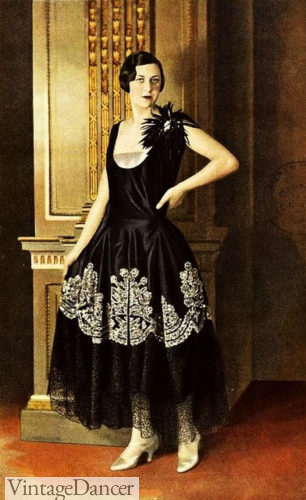

1930s
Women’s fashion softly transitioned from the boyish look of the previous decade into the feminine silhouette of the early thirties. One of the most important trends was the bias cut, a technique that allows the fabric to drape over the body (see picture below).
In addition, the cinema of the 30s and specifically Hollywood had a great impact on fashion. Movie stars like Greta Garbo, Marlene Dietrich, and Bette Davis, among others, became some of the first Hollywood style icons.

1940s
With the outbreak of World War II that led to a shortage of materials and rationing, fashion became practical with uniforms for men and women who served during the war, and utility clothing for other citizens. A common look had padded shoulders, cinched waist, and hemlines below the knee.
One of the results of rationing was the invention of the bikini in 1946 by Jacques Heim (it was called “Atome”, suggesting that the bikini was as small as an atom) and Louis Reard (he was inspired by an atoll in the Marshall Islands that the United States had chosen to target its atomic bombs) “The Atome” and “The Bikini” were seen by both designers as metaphors for the explosion, which was the exact effect the bikini had on fashion and society in the 40s.
After the war, Christian Dior (we covered Christian Dior history here) introduced his iconic “New Look” in 1947, which was a groundbreaking design, much ahead of its time with the cinched-in waist and embodied full skirt. The fashion world had never seen such elaborate designs, using an abundance of fabric to create his lavish, elegant look to celebrate women; it was unheard of to use so much fabric in a time pre-war was full of rationing. But Dior wanted to celebrate life after the war and embrace women’s beauty and feminity encouraging joy and extravagance again.


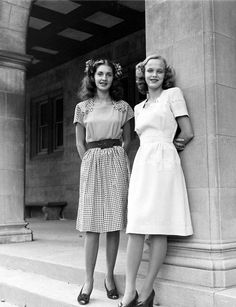
1950s
After years of war marked by rationing and rather strict and sober silhouettes, women had the desire to dress up and look stylish. And so, the 50s were characterized by feminine and elegant silhouettes, with cinched waists and full dresses and skirts.
Dior’s ”New Look” remained popular. However, the decade saw the emergence of other silhouettes as well, which in contrast were straighter and slimmer. A good example is Cristobal Balenciaga’s “Sack dress” from 1957. This fashion design shocked the world, as he pioneered never before seen silhouettes in women’s fashion. He went in a completely different direction than Dior with the broad shoulders and box shapes of the Sack Dress. Contrary to Dior, Balenciaga gave volume to his dresses and skirts through the skillful manipulation of the fabric. While Dior had to rely on built-in corsetry and layered underskirts to achieve volume. Another difference between them is the weight: the Balenciaga gown is only 2.2 pounds. While the Dior garment weighs over 9 pounds.
Another designer who rivaled the Dior New Look was Coco Chanel. She reopened her business in 1954 and reintroduced her signature slim look with boxy jackets and straight skirts.
As you can see, the 50s brought Dior, Balenciaga, and Chanel as the leaders of Paris couture. However, the way they revolutionized women’s fashion is radically different.


1960s
In the early years of the decade, fashion continued along the lines of the 1950s. First Lady Jacqueline Kennedy was the style icon. And Hubert de Givenchy and Cristobal Balenciaga were the major designers to popularize the feminine look still in fashion.
The mid of the decade was known as the “Swinging Sixties” – a cultural phenomenon focusing on youth, spotlighting music and fashion. Mary Quant, André Courrèges, Pierre Cardin, and Paco Rabanne were among the first designers to understand the needs of modern women by creating clothes that felt liberating, daring, and fun while staying practical, and often they questioned conventional gender norms.
The first revolutionary design was the miniskirt whose invention is credited to both Mary Quant and André Courrèges.
Mary Quant made her contribution to the sexual liberation of women with trousers and hotpants, as did Yves Saint Laurent when he invented the first tuxedo for women. With the popularity of androgynous looks, even the models changed. The era’s most high-profile model was Twiggy.
New innovative materials were introduced, such as acrylics, polyesters, PVC (polyvinyl chloride), vinyl, lycra, and metallics. Bright colors began replacing the sober palette of the previous decades.
It was the era of futuristic fashion, as designers were inspired by space travel and technology. As we can see with Courrèges’s “Moon boots”, and Rabanne’s “12 unwearable dresses collection from 1966.
We also have to cite Pierre Cardin, who took inspiration from Pop Art and Op Art to experiment with motifs, geometry, and colors. See his “Egg carton dress” from his landmark 1968 “Cosmocorps” collection, and the “Bubble dress”. Courrèges also had a passion for exploring geometry and wanted to reflect his passion for architecture in his clothes. The designer cut his garments in squares, triangles, and trapezoids, all of which were considered ingenious and striking shapes, and questioned the notion of traditional feminity after the 50s – a time when dominated the use of the perfect hourglass silhouette.
By the late 1960s, fashion began transitioning towards the hippie aesthetic which was a way of rejecting mainstream fashion. Yes, although it’s the 70s that are associated with the hippie look, it actually appeared in the late 60s.



1970s
The decade saw a wide range of popular fashions. Of course, the hippie style was in vogue, particularly with the prairie dresses that were incorporated into high fashion collections. Patchwork, crochet and knitting, embroidery and synthetic materials for which the 70s became known as the “Polyester decade” were common fashion trends.
Later in the decade, the hippie style left room for the glamorous looks of “the disco era” with designer Halston up front.
In the early- to mid-seventies, some designers responded to the sexual freedom of women. For example, in 1971, Yves Saint Laurent launched a 1940s-inspired collection “Libération”, and Diane Von Furstenberg released her timeless “Wrap dress”.
Finally, sportswear made, once again like in the early decades of the 20th century, its entry into women’s fashion. It was mostly popularized by Norma Kamali with her iconic “Sleeping bag coat”, sweats, and a “Parachute” collection of dresses and jumpsuits.
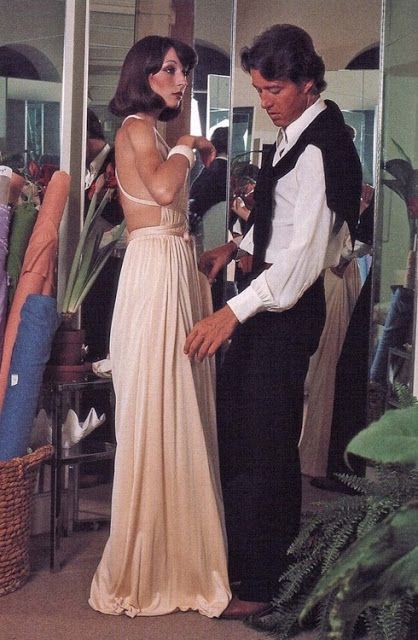


1980s
The 80s was a decade of cultural transformation and the expression of individuality. People were no longer afraid to be who they were, and that mentality was reflected in their fashion choices. They like extravagant styles, bold colors, and accessories were a must. Neon clothes and jumpsuits were a thing, too. Christian Lacroix, Jean-Paul Gaultier, Versace, and Karl Lagerfeld for Chanel, among other fashion designers, responded to that trend.
The increasing popularity of fitness seen in iconic movies like“Dirty Dancing” and “Flashback” inspired off-the-shoulder sweatshirts, sport shorts, spandex, leggings, leg warmers, and headbands.
Music in the 1980s had a great influence on fashion: pop music (big hairstyles, glitter makeup, lots of jewelry); punk (tartan clothing, Doc Martens, leather, and fishnet (Vivienne Westwood opened the decade with stylish sportswear and the soft “New Romantics” style with her 1981 “Pirate” collection) and Hip Hop (loose fitting jeans, sneakers, etc.).
As more women began to work and occupy high-level positions, they were in need of a new wardrobe. That’s how jackets with padded shoulders (see suits by Emanuel Ungaro and Thierry Mugler), bold accessories, and high heels made their entry. Princess Diana, Nancy Reagan, and Margaret Thatcher all popularized the fashion trend of “power suits”.
On the other hand, American designers such as Perry Ellis and Ralph Lauren were turning to a more classic and casual style with the “preppy look”. Which was influenced by traditional Ivy League and Seven Sisters Style, as well as the dress of early 20th century British aristocrats.
Finally, a shocking new type of fashion emerged from Japan and differed from the Western styles. Designers such as Comme des Garçons’ Rei Kawakubo and Yohji Yamamoto employed deconstruction, exaggerated proportions, and presented black as the new it color.


1990s
The beginning of the 1990s was the peak of the Supermodel era. Among the most celebrated were Linda Evangelista, Cindy Crawford, Naomi Campbell, and Christy Turlington, known as “the original supermodels”.
The sportswear looks of the eighties continued into the early nineties with biker shorts, leggings, Keds, and oversized sweatshirts continuing to be favorite choices for young women.
Then, fashion towards a more casual style of dressing and minimalism. The slip dress was the biggest fashion trend. The supermodels were replaced by the “heroin chic” models, a type of model epitomized by Kate Moss.
The three main subcultures of the 90s were Grunge fashion pioneered by Marc Jacobs and Alexander McQueen, (loose-fitting, worn-out jeans, flannel shirts, Doc Martens, and chunky boots) the preppy style, (oversized shirts, high-waisted jeans, plaid mini-skirts) and Punk (black leather jackets, ripped jeans, choker necklaces). In addition, women wore overalls, swirl patterns, leopard print, scrunchies, bandanas, crop tops, tie-dye…
The music and film industry with Destiny’s child, The Spice Girls, Clueless, The Fresh Prince of Bel-Air, Britney Spears…influenced these popular fashion trends of the 90s.

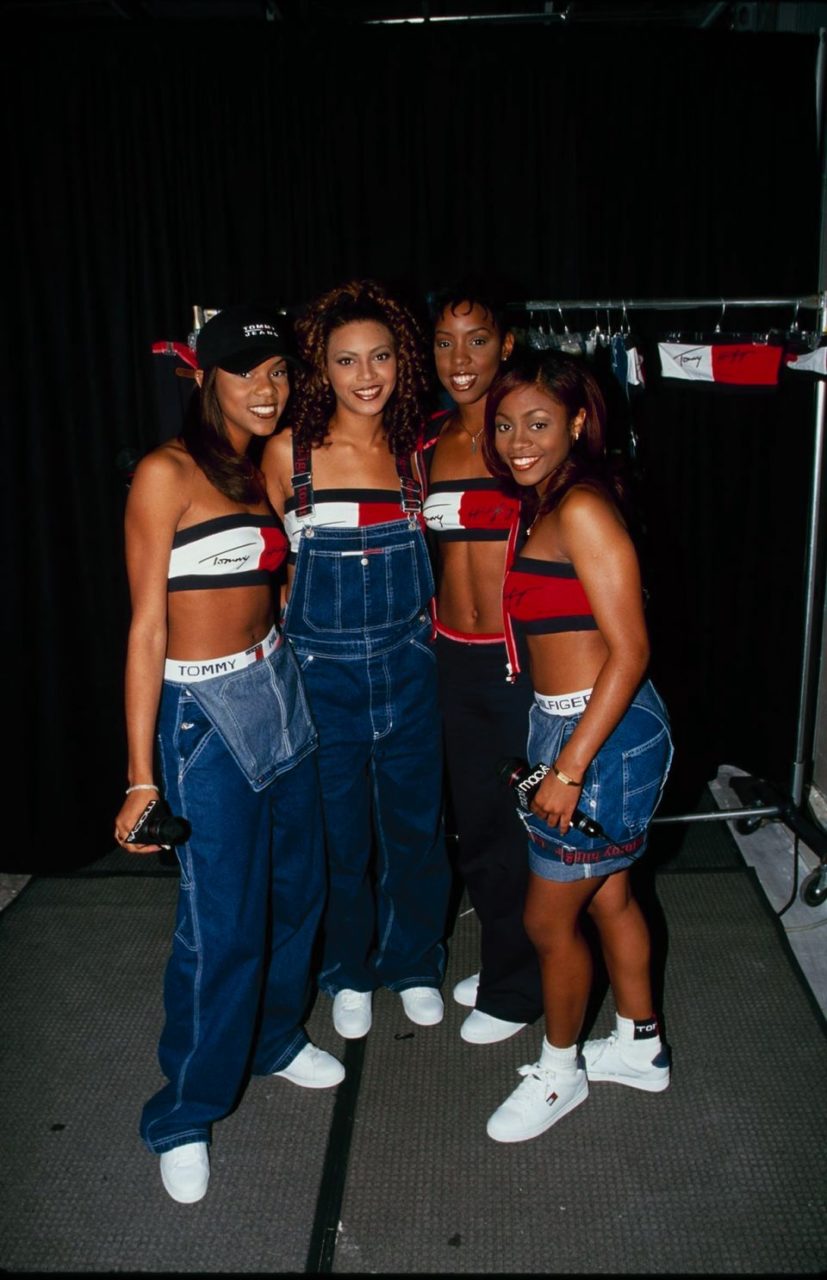

2000s
Fashion at the rise of the 21th century was similar to the one in the late 1990s. But due to globalization and the rise of fast fashion, when affordable clothes inspired by runway designs can now be found in department stores like Mervyn’s, J.C. Penney, and Macy’s) fashion trends became even more widespread. Moreover, celebrities and characters from TV shows such as The OC, One Tree Hill, and Gossip Girl were the style icons of the decade and influenced many people.
Fashion was also marked by the rapid development of technology, which translated into fashion. The Matrix movie in particular inspired a few designers like Balenciaga, Calvin Klein, and Yves Saint Laurent to use almost exclusively black for their Fall 2001 collections.
After the tragic events of 9/11, fashion returned to conservatism, casual clothing, and leisurewear, and the most dominant item was jeans. Its style evolved throughout the years: low-rise, bell-bottom pants, skinny, ripped, or otherwise worn jeans. They became an acceptable item to wear in nearly all occasions. Sneakers were an important part of the look, especially retro Nike Air Jordan’s and Adidas Yeezys. Platform heels and Ugg boots were also in fashion. Another trendy piece was the tracksuit, worn by the likes of Jennifer Lopez, Paris Hilton, Britney Spears, and TV show actresses.
The predominant looks of the decade were the bohemian (or boho) look that replaced the grunge look of the nineties (vintage and handmade clothing was in vogue), hip-hop, streetwear, Y2K, scene, emo, and athleisurewear. These different subcultures of the 2000s influenced fashion in different ways.
:max_bytes(150000):strip_icc()/070819-oc-style-embed-05-2000-1d1c2be65851475caa23257ac25fd8db.jpg)


2010s
Throughout the 2010s, many women wore workout gear not just for sport, but as casual everyday wear. This style that emerged in the previous decade with the tracksuit and came to be known as athleisure continued during the 2010s.
Although before it was celebrities who partly dictated the trends, in the 2010s, it was fashion bloggers and influencers due to the rise of social media.
There was also a return to maximalism from the 1980s. A pivotal moment was in 2015 when Alessandro Michele took over as creative director of Gucci (we talked about the history of Gucci here) and brought bright colors and bold textures to the collections. Other designers supported this trend, like Demna Gvasalia for Balenciaga and Hedi Slimane at Yves Saint Laurent.
Finally, besides the trends themselves, the 2010s brought a bigger focus on sustainability issues. Both consumers and companies began to speak about the impact of fashion on the environment, and the working conditions of factory workers.
2020s
The outbreak of Covid had a long-lasting impact on fashion. People adopted cozy and practical clothing, and activewear became a fashion trend again. The value of comfort persisted after the lockdown, so the minimalism of the 90s resurfaced. So far, the 2020s also brought back trends characteristic of other decades, like mini dresses and skirts from the 60s, and the Y2K trend from the 2000s. Let’s see what the next years of the decade will bring.
This is it for now for the brief fashion history through the decades. We went through the most important fashion trends, pieces, subcultures and designers you need to know. And what’s your favorite decade in fashion? We would love to hear from you. In the comments below.
Want to learn more in detail about the history of fashion? Enroll in our online course Inside the fashion industry.
If you want to transform your passion for fashion into a career in the industry, register for our free masterclass here to learn 3 top strategies to get a job in fashion.





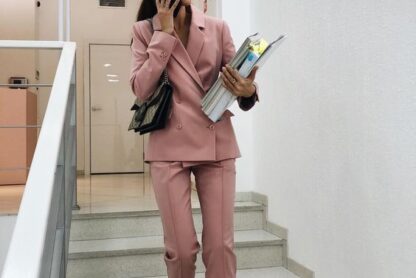

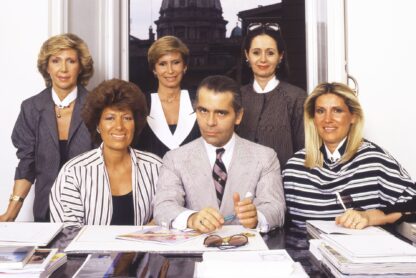
I’m happy to walk you through any specific decade or style that interests you, or we can embark on a broader journey, weaving through the decades and highlighting iconic trends, influential designers, and fascinating tidbits of fashion history.
I’m using your article for a big project on fashion trends throughout the decades, do you have any suggestions of what i should add or make sure to include? Key points basically?
Me to sylvanas! Can u give me tips if you got any please
Late but i suggest phttibg pictures with it and findibg other resource’s its rllly helpful!!!
Idk
Step into the fashion time machine! From S-shaped forms to today’s athleisure, which era speaks to your style? Share below
This article about your fashion is very helpful for learning new knowledge for me, but your article will be more interesting if you have tried playing the best online game site in Asia, namely Rajawali888
DR JESSICA PITTSBURGUE (MS) SAYS THAT:-
My Experience with Trending Fashion in the USA: Zazzle Marketplace’s Top Picks
As someone who loves staying on top of fashion trends in the USA, I’ve found the Zazzle Marketplace to be a fantastic destination, especially the TrendingOnlineStore. Zazzle offers a wide variety of customizable garments, with t-shirts being a standout. Whether you’re looking for a simple, casual style or a bold, personalized design, Zazzle’s t-shirts combine comfort with creativity. The unisex fit and high-quality cotton fabric make them a go-to for everyday wear.
One of the most exciting experiences I’ve had with Zazzle is finding baby shower fashion and gifts. Their baby shower items are perfect for celebrating the arrival of a little one. From custom t-shirts for expecting parents to personalized baby shower gifts, Zazzle’s marketplace allows you to create meaningful, one-of-a-kind pieces that make the event even more special.
Fashion on Zazzle isn’t just about what’s trending; it’s about what fits your personal style and occasion. Their selection of garments and baby shower essentials has made it easier for me to find thoughtful, custom options that cater to any event or trend. With high-quality materials and vibrant designs, the TrendingOnlineStore has become my go-to for both fashion staples and unique gifts.
If you’re looking to stay stylish and on-trend, I highly recommend exploring what Zazzle’s TrendingOnlineStore has to offer!
click below to grab this unique offer only for you
https://www.zazzle.com/store/trendingonlinestore